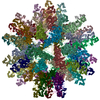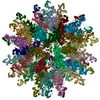+Search query
-Structure paper
| Title | Structure of anellovirus-like particles reveal a mechanism for immune evasion. |
|---|---|
| Journal, issue, pages | Nat Commun, Vol. 15, Issue 1, Page 7219, Year 2024 |
| Publish date | Aug 22, 2024 |
 Authors Authors | Shu-Hao Liou / Rajendra Boggavarapu / Noah R Cohen / Yue Zhang / Ishwari Sharma / Lynn Zeheb / Nidhi Mukund Acharekar / Hillary D Rodgers / Saadman Islam / Jared Pitts / Cesar Arze / Harish Swaminathan / Nathan Yozwiak / Tuyen Ong / Roger J Hajjar / Yong Chang / Kurt A Swanson / Simon Delagrave /  |
| PubMed Abstract | Anelloviruses are nonpathogenic viruses that comprise a major portion of the human virome. Despite being ubiquitous in the human population, anelloviruses (ANVs) remain poorly understood. Basic ...Anelloviruses are nonpathogenic viruses that comprise a major portion of the human virome. Despite being ubiquitous in the human population, anelloviruses (ANVs) remain poorly understood. Basic features of the virus, such as the identity of its capsid protein and the structure of the viral particle, have been unclear until now. Here, we use cryogenic electron microscopy to describe the first structure of an ANV-like particle. The particle, formed by 60 jelly roll domain-containing ANV capsid proteins, forms an icosahedral particle core from which spike domains extend to form a salient part of the particle surface. The spike domains come together around the 5-fold symmetry axis to form crown-like features. The base of the spike domain, the P1 subdomain, shares some sequence conservation between ANV strains while a hypervariable region, forming the P2 subdomain, is at the spike domain apex. We propose that this structure renders the particle less susceptible to antibody neutralization by hiding vulnerable conserved domains while exposing highly diverse epitopes as immunological decoys, thereby contributing to the immune evasion properties of anelloviruses. These results shed light on the structure of anelloviruses and provide a framework to understand their interactions with the immune system. |
 External links External links |  Nat Commun / Nat Commun /  PubMed:39174507 / PubMed:39174507 /  PubMed Central PubMed Central |
| Methods | EM (single particle) |
| Resolution | 2.8 - 3.98 Å |
| Structure data | EMDB-27077, PDB-8cyg: EMDB-43009, PDB-8v7x: |
| Source |
|
 Keywords Keywords | VIRUS LIKE PARTICLE / anellovirus / Anello Virus: Virus Like Particle (VLP) |
 Movie
Movie Controller
Controller Structure viewers
Structure viewers About Yorodumi Papers
About Yorodumi Papers







 anelloviridae (virus)
anelloviridae (virus)